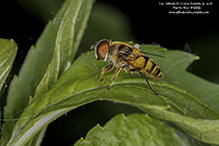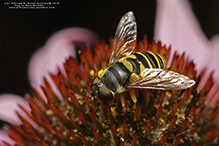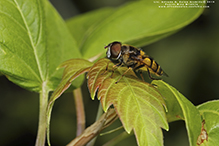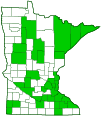Transverse flower fly
(Eristalis transversa)
Conservation • Description • Habitat • Ecology • Distribution • Taxonomy
Conservation Status |
|||
| IUCN Red List | not listed |
||
| NatureServe | not listed |
||
| Minnesota | not listed |
||
Description
Transverse flower fly is a moderate-sized hoverfly. It occurs in the United States from Maine to South Dakota, south to Texas and Georgia, and in Ontario and Quebec. It is common in most of its range, including eastern Minnesota.
Adults are ⅜″ to 7 ⁄16″ long and very hairy. Larvae of the genus Eristalis are known as rat-tailed maggots.
The head is hemispherical and slightly wider than the thorax. There are two large compound eyes on the sides of the head and three small simple eyes (ocelli) in a triangle on top of the head. On the male the eyes meet at the top of the head. On the female they do not. The upper half of each compound eye is conspicuously covered with short erect hairs. The face is densely hairy and is not projected forward. The antennae are short and have just three segments. The first and second segments are short and mostly reddish-yellow, brownish or blackish just at the joints. The third segment is oval and mostly reddish-yellow, brownish or blackish just on the top. At the base of the third segment there is a reddish bristle (arista). The arista has sparse, fine hairs, giving it a feathery (plumose) appearance just near the base.
The thorax is large and opaque black with two grayish, broad, horizontal bands. It is covered with abundant short, erect, yellow hairs. The exoskeletal plate on the third thoracic segment (scutellum) is large, rounded, and mostly bright yellow but with a narrow black band at the base.
The abdomen is longer and broader than the thorax, elliptical when viewed from above, and convex when viewed from the side. It is black with bright yellow markings. There are five visible segments. On the male, segment 1 is very narrow and entirely black. Segment 2 has a large yellow triangle on each forward lateral margin and a bright yellow band at the rear margin. Segment 3 has a broad rectangular yellow spot on each side at the forward margin and a yellow band at the rear margin. Segment 4 has a small yellow spot on each forward lateral margin, a yellow band on the rear margin, and a grayish shining band in the middle. The abdomen is densely covered with short erect hairs, black hairs in the black areas, yellow hairs in the yellow areas. On the female the abdominal markings are very different. The triangles on segment 2 are smaller. There are no rectangular markings on segment 3. Segments 2 through 5 all have a narrow yellow band on the rear margin and a grayish shining band near the front. On segment 3 there is sometimes a narrow yellow stripe on each side at the front margin.
The legs are variable but are usually mostly black with yellow at the tip of the third segment (femur) and at the base of the fourth segment (tibia). The femurs on the hind leg is slender, not thickened.
The wings are mostly clear, a little yellowish at the base. There is a spurious vein between the radius (R) and media (M) veins. The cross-vein that runs between the radius and media veins (R-M cross-vein) does so near the middle of the discal cell. The anal cell is long and is closed near the wing margin. The marginal, R5, and M2 cells are also closed.
Size
Total length: ⅜″ to 7 ⁄16″
Similar Species
Habitat
Ecology
Season
Late April to mid-October
Behavior
Adults are found on flowers.
Life Cycle
Eggs are sometimes laid in beetles
Larva Food/Hosts
Aphids and other soft-bodied insects, decaying organic matter
Adult Food
Flower pollen and nectar and aphid honeydew
Distribution |
||
|
Sources Biodiversity occurrence data published by: Minnesota Biodiversity Atlas (accessed through the Minnesota Biodiversity Atlas Portal, bellatlas.umn.edu, 9/30/2025). Telford, Horace S.. (1939). The Syrphidae of Minnesota. University of Minnesota. Minnesota Agricultural Experiment Station. |
|
| 9/30/2025 | ||
Occurrence |
||
Common and widespread |
||
Taxonomy
Order
Suborder
Brachycera
Infraorder
Cyclorrhapha
Zoosection
Aschiza
Family
Syrphidae (Hover Flies)
Subfamily
Eristalinae (Drone Flies and Allies)
Tribe
Eristalini (Rat-tail Maggot Flies)
Subtribe
Eristalina
Genus
Subgenus
Eoseristalis
Subordinate Taxa
Synonyms
Eristalis fascicollis
Eristalis philadelphicus
Eristalis pumilus
Eristalis transversus
Eristalis vittata
Eristalis zonatus
Eristalomyia calomera
Common Names
transverse flower fly
transverse-banded drone fly
transverse-banded flower fly
Glossary
Arista
A large bristle on the upper side of the third segment of the antenna of a fly. Plural: aristae.
Femur
On insects and arachnids, the third, largest, most robust segment of the leg, coming immediately before the tibia. On humans, the thigh bone.
Ocellus
Simple eye; an eye with a single lens. Plural: ocelli.
Scutellum
The exoskeletal plate covering the rearward (posterior) part of the middle segment of the thorax in some insects. In Coleoptera, Hemiptera, and Homoptera, the dorsal, often triangular plate behind the pronotum and between the bases of the front wings. In Diptera, the exoskeletal plate between the abdomen and the thorax.
Tibia
The fourth segment of an insect leg, after the femur and before the tarsus (foot). The fifth segment of a spider leg or palp. Plural: tibiae.
Visitor Photos
Share your photo of this insect.
This button not working for you?
Simply email us at info@MinnesotaSeasons.com.
Attach one or more photos and, if you like, a caption.
Alfredo Colon |
||
 |
 |
|
 |
||
MinnesotaSeasons.com Photos
|

Slideshows
Transverse Flower Fly (Eristalis transversa)
Andree Reno Sanborn

Visitor Videos
Share your video of this insect.
This button not working for you?
Simply email us at info@MinnesotaSeasons.com.
Attach a video, a YouTube link, or a cloud storage link.
Other Videos
Transverse Flower Fly (Eristalis transversa) - Working
Nature's Wild Things
Transverse Flower Fly - August 31 2013
Don Gagnon

Visitor Sightings
Report a sighting of this insect.
This button not working for you?
Simply email us at info@MinnesotaSeasons.com.
Be sure to include a location.
Minnesota Seasons Sightings




